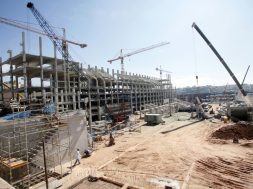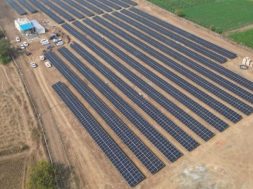High rise buildings have now almost become the order of the day in mega cities due to various factors. An attempt is made here to explain these factors that have made high rises in residential and commercial building segment a necessity without touching upon effects of proliferation of high rise buildings
Land – a fixed resourceSaying that land is a fixed resource is stating the obvious. The net availability of land for building construction is much less than the total land mass because a significant portion is occupied by natural features like water bodies, hills, forests etc. Land is also occupied by historic monuments. Physical infrastructures like roads, railways, airports, ports, reservoirs etc. also occupy land. Social necessities like playgrounds, parks, cremation and burial grounds also occupy sizeable land parcels. In Greater Mumbai, the land-use distribution shows that built-up area covers 181.9 sq. km. (excluding industries) out of a total area of 469 sq. km. which amounts to around 39 per cent.Earlier, land mass had been increased by reclaiming marshes and creek lands. But with environmental lobbies rightly becoming very proactive and powerful and with strict enforcement of Coastal Regulation Zone, that avenue is now virtually closed.
Rapid urbanisationPost World War-II, there was increasing migration of rural folks to cities which thus transformed them into mega cities. This influx led to rapid urbanisation. Add to this, the natural growth of the existing population. The population of greater Mumbai in 1971 was 5.97 million and rose to 12.93 million in 2011, representing an increase of more than 100 per cent. This resulted in increasing pressure on available land.
This migration occurs because cities are centres of commerce and industry and are often seats of administration. This gives rise to job opportunities which attracts rural population. It is worth noting that 26.6 per cent of the total population of Maharashtra resides in six major cities – Mumbai, Pune, Nagpur, Nashik, Aurangabad and Vasai – Virar.Effect of Public PolicyUrbanisation has created large pockets of slums in all the cities. Here, people live in small single room jhuggis, but nonetheless aspire for something more. The State has made efforts to ameliorate the living conditions of slum dwellers through various schemes like slum improvement schemes, slum clearance schemes, squatters, rehabilitation schemes and JNNURM. But these efforts have only made a dent in the problem. The problem is too gigantic to be tackled by the state alone.
Therefore, the State has come up with the concept of Slum Rehabilitation Scheme, wherein a developer builds tenements of a certain size for the slum dwellers who get them for free and in turn the developer gets additional floor area ratio (FAR) which is used for building flats for middle and higher income groups to be sold at market price. In other words, the state incentivises such schemes by granting higher FAR.
Obviously, the higher FAR can be utilised only by building high rises, especially for the sale component of such a project.
The same is true of the cessed buildings in the island city of Mumbai. The landlords and tenants of old dilapidated buildings are unable and / or unwilling to repair / reconstruct these. Repairing these old buildings might not be economically feasible for the existing landlords and tenants.
Here the state has allowed for redevelopment wherein the tenants will get dwellings (which are larger than their existing tenements) for free and the developer gets higher FAR to build flats for higher income groups to make the scheme viable. The only way to utilise this higher FAR is to go in for high rise buildings.
Socio-economic and socio-cultural changesIn India, the income levels have steadily risen in all societal segments. This in turn brought about a continuous rise in aspirations which are further fuelled by the mass media creating a demand for quality living.
There was a time when a large joint family would live in a single room of modest size. Today, the joint family is on its way out, at least in cities and the resultant nuclear families desire something more than a single room shelter.
Rising Demand for Goods and ServicesRising population coupled with rising aspirations has caused an ever-increasing demand for goods and services. This causes more land to be used for setting up factories, educational institutions, healthcare facilities and leisure & entertainment facilities.
Necessity of more infrastructuresRising population and consequent increased demand for goods makes it necessary to expand the road and rail network which in turn requires more land. All this has drastically reduced availability of land for residential and commercial buildings. Thus the only way to provide residential and commercial space is to go for vertical expansion.
DC RegulationsDevelopment control regulations also play their part. They mandate certain minimum open spaces on all sides so that occupants derive adequate light and ventilation and also to facilitate movement of fire engines. They also prescribe minimum area for recreation ground. All these reduce the footprint of a building and in order to fully utilise the permissible floor area ratio, the only alternative left is to move upwards.
Parking Spaces and other amenitiesWith increasing vehicle population which itself is a fall-out of the rising income levels and consequent rise in aspirations, both residential and commercial buildings require adequate car parking space. Spacious entrance lobbies and club facilities have become a necessity. All these have to be accommodated on the lower floor and residential & commercial spaces have to be moved to upper floors increasing the height of the building.
All the above factors highlight the inescapable need of building high rise buildings especially when it comes to in mega cities.
Jeet Kapadia, Management Executive, B. E. Billimoria & Co. Ltd. Mr. Kapadia passed B. Tech. (Civil) in 2009 from the Victoria Jubilee Technical Institute affiliated to University of Mumbai and did his post-graduation from Columbia University, New York. He has hands-on experience in various formwork systems and strategic management in construction. His areas of special interest include urban affairs, green buildings and construction planning and management.
28
Cookie Consent
We use cookies to personalize your experience. By continuing to visit this website you agree to our Terms & Conditions, Privacy Policy and Cookie Policy.









